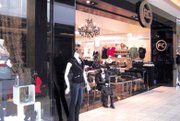German Retailer Fashion Club Debuts First U.S. Store in L.A.
After months of scouting Los Angeles retail locations and putting the finishing touches on its wide range of merchandise, a fast-fashion German retailer has quietly rolled out its first store in the United States.
Fashion Club, whose price-conscious clothes appeal to women ages 18 to 35, opened its doors in late September at the upscale Westfield Topanga shopping center, located near Canoga Park and Woodland Hills in the San Fernando Valley.
The store has a clean look, with black marble columns, black chandeliers and shiny white floors. There is an array of trendy dresses, blouses, jeans, boots and accessories, with items ranging from casual to out-on-the-town looks.
Skinny-legged jeans sell for $19, knee-high boots go for $27 and strapless evening dresses have a $50 price tag. Store employees said the company is hoping to open a second California store in the next few months in West Hollywood or Santa Monica.
Fashion Club is the newest retail chain owned by United Fashion Brands Inc., founded in Berlin in the mid-1990s by Rainer Schulz and his wife, Silke. They did not respond to e-mails or phone calls to comment about their new store.
While some question the wisdom of adding more stores to an oversaturated market, analysts note that store rents are low and space is abundant, which makes for a perfect time to test the market.
“Obviously, international retailers are coming to the United States because it is much more affordable from an occupancy and cost perspective,” said Jeff Green, a retail consultant who heads Jeff Green Partners in Phoenix. “And when you are making your entry into the United States, Manhattan and Los Angeles are the only two possible places if you are fashion-forward.”
United Fashion Brands has plenty of experience in the fashion field. The company’s two other chains, Forever 18 and Colloseum, now have more than 250 stores in Germany, Poland, Russia, Austria, Latvia and Lithuania, with a sourcing office in Hong Kong. Its European headquarters is now in Vienna.
Forever 18 is geared forward young women and girls. Colloseum is for the slightly older shopper, ages 15 to 25. Fashion Club is catering to the next age group up.
“It’s kind of like Forever 21,” said Noushin Seifianjoo, who was checking out the merchandise. “The prices are very good.” Moving faster in fashion
Fast-fashion stores from Europe have made huge inroads into the U.S. retail market.
Spanish fast-fashion retailer Zara ventured into the United States in 1989.
Next was Swedish fast-fashion retailer H&M, which opened its first U.S. store in early 2000 in Manhattan. It now has nearly 200 stores in the United States.
Undoubtedly, the success of their fellow European fast-fashion retailers wasn’t lost on Rainer and Silke Schulz. So they decided to get a first-hand look at Southern California’s retail landscape by renting a home in Malibu and opening an office in the heart of Los Angeles’ Fashion District.
Their U.S. headquarters are on the sixth floor of the Gerry Building in a modern and glitzy office decorated in all white and accented with mid-century light fixtures. It is the hub for plotting the company’s expansion into California and hiring employees.
But the company has been relatively low-key in announcing its presence in California. “It’s a new chain that is going to take a while to mature,” said retail consultant Green.
United Fashion Brands joins a small band of foreign retailers that, since the recession ended, have come to the United States to boost their revenues. In late 2009, Australian retailer Cotton On started a slow but steady rollout in California at mall-based stores appealing to young customers who want cheap and casual clothes rarely selling for more than $30. Cotton On—with its jeans, T-shirts, cardigans and dresses—now has 11 stores in California, a small percentage of the more than 660 stores the retailer commands in Australia, New Zealand, Malaysia, Singapore and Hong Kong. Cotton On felt it had saturated its immediate geographical market and needed to expand to the United States to bolster its revenues, company sources said.
The same goes for Accessorize, a British chain that has 750 stores after 27 years in the business. It targets its handbags, purses, wallets, shoes, hats, gloves, jewelry and watches to women ages 18 to 35. The company felt it didn’t have any major competition in the United States, leaving the market wide open, said company founder Peter Simon in published reports.
Accessorize opened its first U.S. store, on Bleecker Street in New York, in late October. Another small store is scheduled to open at New York’s 1 Union Square West in mid-November. The goal is to have 100 storefronts in the United States by 2015.
But it is the fast-fashion category that is growing most rapidly in the United States, fueled by cost-conscious shoppers.
IBIS World, a Santa Monica, Calif.–based company that publishes U.S. industry research reports, notes that fast-fashion retailers now make up 10 percent of the women’s clothing market in the United States, up from 5 percent in 2005.
“Fast fashion is definitely coming up a lot because our mindsets are kind of changed toward bargain hunting and frugality,” said Nikoleta Panteva, a retail analyst with IBIS World. “It is not something that is going to fade away overnight.”























